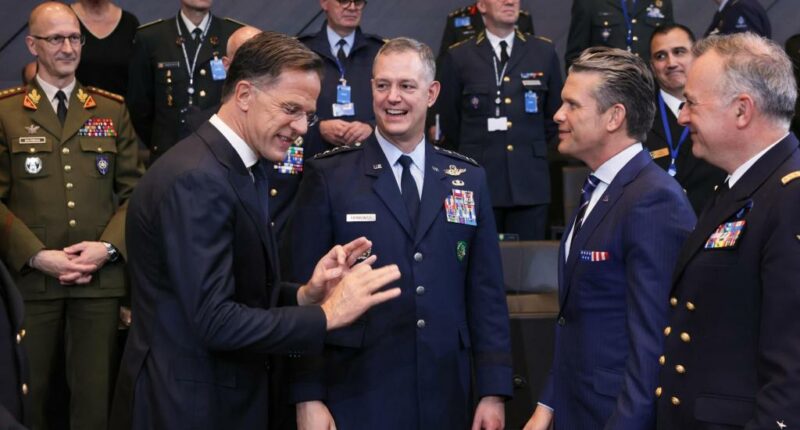Share this @internewscast.com

By LORNE COOK, Associated Press
BRUSSELS (AP) — On Wednesday, Germany committed over $2 billion for military assistance to Ukraine. Meanwhile, Kyiv stated it requires $120 billion by 2026 to counter Russia’s prolonged nearly four-year aggressive warfare.
Defense Minister Boris Pistorius announced that under a new rapid deployment initiative, Germany will purchase $500 million in American armaments for Ukraine. Estonia, Finland, Lithuania, and Sweden are also expected to join this funding effort.
Pistorius highlighted that Germany’s “package caters to several critical needs of Ukraine, offering air defense systems, Patriot missile interceptors, radar technologies, and precision-guided artillery, rockets, and munitions.”
He further mentioned Germany’s plan to supply “two additional Iris-T air defense systems with numerous guided missiles, along with shoulder-launched air defense missiles.” Additionally, anti-tank weaponry, communication gadgets, and handheld arms are slated for delivery.
NATO’s fast-track funding program
Throughout the summer, trans-Atlantic allies began synchronizing the steady dispatch of substantial arms shipments to Ukraine to aid in repelling Russia’s assault. Their aim was a consistent monthly shipment valued at approximately $500 million, providing strategic and reliable military aid.
European weapon reserves have nearly depleted, leaving the United States as the sole country with an ample stockpile of the essential weaponry Ukraine demands.
Under the financial arrangement — known as the Prioritized Ukraine Requirements List, or PURL — European allies and Canada are buying American weapons to help Kyiv keep Russian forces at bay. About $2 billion worth had previously been allocated since August.
Finland’s defense minister, Antti Häkkänen, said that his country has “decided to join the PURL, because we see that it’s crucial that Ukraine gets the critical U.S. weapons.” Finland will also provide a separate package of its own military equipment.
Swedish Defense Minister Pål Jonson said that “Sweden stands ready to do more.” He welcomed discussions among other Nordic countries and the Baltic nations — Estonia and Lithuania — on helping to make up another load too.
Ukraine’s striking needs for 2026
Germany’s pledge came after a meeting of NATO defense ministers in Brussels, as Ukraine’s Western backers gathered to drum up more military support for their beleaguered partner.
Ukrainian Defense Minister Denys Shmyhal put his country’s defense needs next year at $120 billion.
“Ukraine will cover half, 60 billion, from our national resources. We are asking partners to join us in covering the other half,” he said. He said that “the most efficient, effective, fast” way for Kyiv’s backers to do that would be “to dedicate no less than 0.25% of their GDP (gross domestic product) to military support.”
Air defense systems are most in need. Shmyhal said that last month alone, Russia “launched over 5,600 strike drones and more than 180 missiles targeting our civilian infrastructure and people. Therefore, on the eve of winter, it is very critical to provide us with necessary equipment to repel such attacks.”
Dwindling support
The new pledges of support came a day after new data showed that foreign military aid to Ukraine had declined sharply recently. Despite the PURL program, support plunged by 43% in July and August compared to the first half of the year, according to Germany’s Kiel Institute, which tracks such deliveries and funding.
Jonson said that Sweden believes its aid “is critical now, because we’ve been seeing the wrong trajectory when it comes to support to Ukraine, that it’s been going down and we want to see more stepping up.”
Estonian Defense Minister Hanno Pevkur also expressed concern about a drop in Western backing, noting that “the reality is that the share of the U.S. contributions to Ukraine has decreased significantly this year.”
U.S. Defense Secretary Pete Hegseth said that “all countries need to translate goals into guns, commitments into capabilities and pledges into power. That’s all that matters. Hard power. It’s the only thing belligerents actually respect.”
The Trump administration hasn’t donated military equipment to Ukraine. It has been weighing whether to send Tomahawk long-range missiles if Russia doesn’t wind down its war soon, but it remains unclear who will pay for those weapons, should they ever be approved.
Sharing the burden
Criticism has mounted that France, Italy and Spain aren’t doing enough to help Ukraine, and Häkkänen called on all 32 NATO allies to take on their “fair share of the burden,” saying that “everyone has to find the money because this is a crucial moment.”
France and Italy are mired in debt and struggling to raise money just to meet NATO’s defense spending targets. Spain says it has other economic concerns and insists that it makes up for its spending gap at NATO by deploying troops on the alliance’s missions.
France also believes that European money should be spent on Europe’s defense industry, not in the United States, and it doesn’t intend to take part in PURL.
Originally Published: October 15, 2025 at 10:51 AM EDT
















